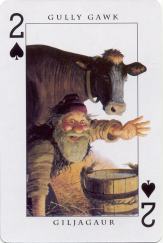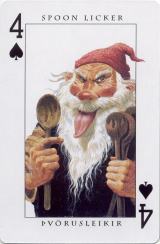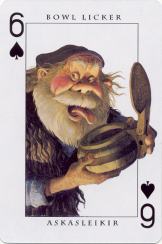
on

on
-1-
| Ever since man started noticing returning events in the nature
of the surrounding world, he began interpreting and celebrating them. The summer
and winter solstices have lead to celebrations and festivities on both the
southern and northern hemisphere. It's not hard to imagine that in the dark
winter high up in the northern hemisphere, with it's short daylight periods, the
lenghtening of the days -the slow return of light- was something to be thankful
for and to celebrate. The mid-winter festival of Yule, that is held in Iceland
and other Nordic countries, has it's origins in those celebrations.
The name Yule or Jól or Jul was already in use well before the year 1000. There is no consensus about the origin of the name. Some say that is originates from the Nordic word for "wheel", others claim that Julius Caesar has lend his name to it, but most likely it is just a name that was given to this specific festival. Later Christians have transformed the pagan festival into Christmas, celebrating the birth of Christ, a symbol of light. Most of the original mid-winter celebrations and festivities around the world lasted for 12 days or longer. The Christian Advent calendar is probably derived from this, but it starts on December 1st and ends the day before Christmas. |
|
|
|
The Yule in Iceland starts on December 12th. Then
Stekkjastaur, the first of
the Jólasveinar or Yuletide lads, will come down from the mountains into town.
Although they were originally seen as playful imps whose main interest
seemed to be getting their hands on some of the seasonal food and other
goodies, or lurking about trying to do some minor mischief, their role
has changed a bit and they have more become "santa's" nowadays. It
is an old custom for children to put a shoe in the windowsill, when the
Jólasveinar come to town. If the child has behaved good, it will find a
little gift in his shoe. If not, there will be a potato in the
shoe. |
THE YULETIDE LADS
|
|
The Yuletide lads are the sons of Grýla and Leppalúđi, a pair of child eating and bloodthirsty old people. Leppalúđi is bedridden and Grýla is said to steal children, that have not behaved good, during the Yuletide. That made her a popular means of making children behave throughout the centuries. |
|
There are 13 Jólasveinar and there are 13 cards in a suit, so it is not a surprise that each of these decks has a repeated series of 13 designs, from Ace to King. Although they have been known under many names -at least seventy- there seems to be consensus about their present names. |
|
We'll introduce the Jólasveinar through 4 decks, that were published on Iceland during the last 5 years:
1/ A childrens's deck of Santa's, slightly smaller
than usual, with cartoonlike drawings. The deck was published in 1999 and
contains 52 cards and 4 extra cards (jokers?).
2/ The
"Jólasveinaspilin" was drawn by Lúđvik Kalmari Viđissyni. It was
printed by Carta Mundi, contains 52 cards and 3 jokers and was published in
2004. The backdesign (first picture above) shows the decent of the Jólasveinar.
3/
The "Islensku Jólasveinarnir" or "Icelandic Yuletide Lads" deck shows Grýla, Leppalúđi and the
Jólaköttur (Yule Cat) on the backdesign (above on the left). The deck consists
of 52 cards and 2 jokers and was probably printed by Carta Mundi.
Published by Snerruútgáfan from
Reykjavik and illustrated by Selma
Jónsdóttir.
4/ The
"Jólasveinarnir Jóla Spil" or "Icelandic Yule Lads" deck
was published by Sólarfilma from Reykjavik, probably in 2004. It was illustrated
by Brian Pilkington and has 52 cards and 2 similar jokers, representing Grýla.
|
1 |
DECEMBER 12th Stekkjastaur is the first to come into town. In the different decks we notice that this character is obviously not spelled the same in Icelandic, nor is the English translation consistent. In deck 4 the word "Stekkjarstaur" is used and the English "Sheep Cot Clod" from deck 3 means something completely different than the "Sheep Worrier" from deck 4. Also notice that the Stekkjastaur from deck 1 has the wrong design. The design of the Giljagaur here below would be fitting.
|
|
|
|
|
|
|
2 |
3 |
4 |
|
DECEMBER 13th Giljagaur is after the milk, as told in this (translated) Icelandic rhyme........ Gully Gawk was the second, |
|
|
|
|
|
 |
|
|
DECEMBER 14th
Stúfur is a short and tubby one. He seems rather nice, but in deck 3 we see the object of his desire: a pan. He likes to pick the foodbits that are stuck to the pan.
|
|
|
|
|
|
|
DECEMBER 15th Ţvörusleikir likes to lick the spoons or pot-scrapers, or in Icelandic rhyme...... The fourth, Pot-Scraper
Licker, |
|
|
|
|
|
 |
|
|
DECEMBER 16th
Pottasleikir is the pot licker or scraper. He knocks on the door and when everybody rushes to see who it is, he runs to the pot and has a meal.
|
|
|
|
|
|
|
DECEMBER 17th Askasleikir's favourite is a bowl, preferably a full one........ The sixth, Bowl Licker, When the bowls were placed |
|
|
|
|
|
 |